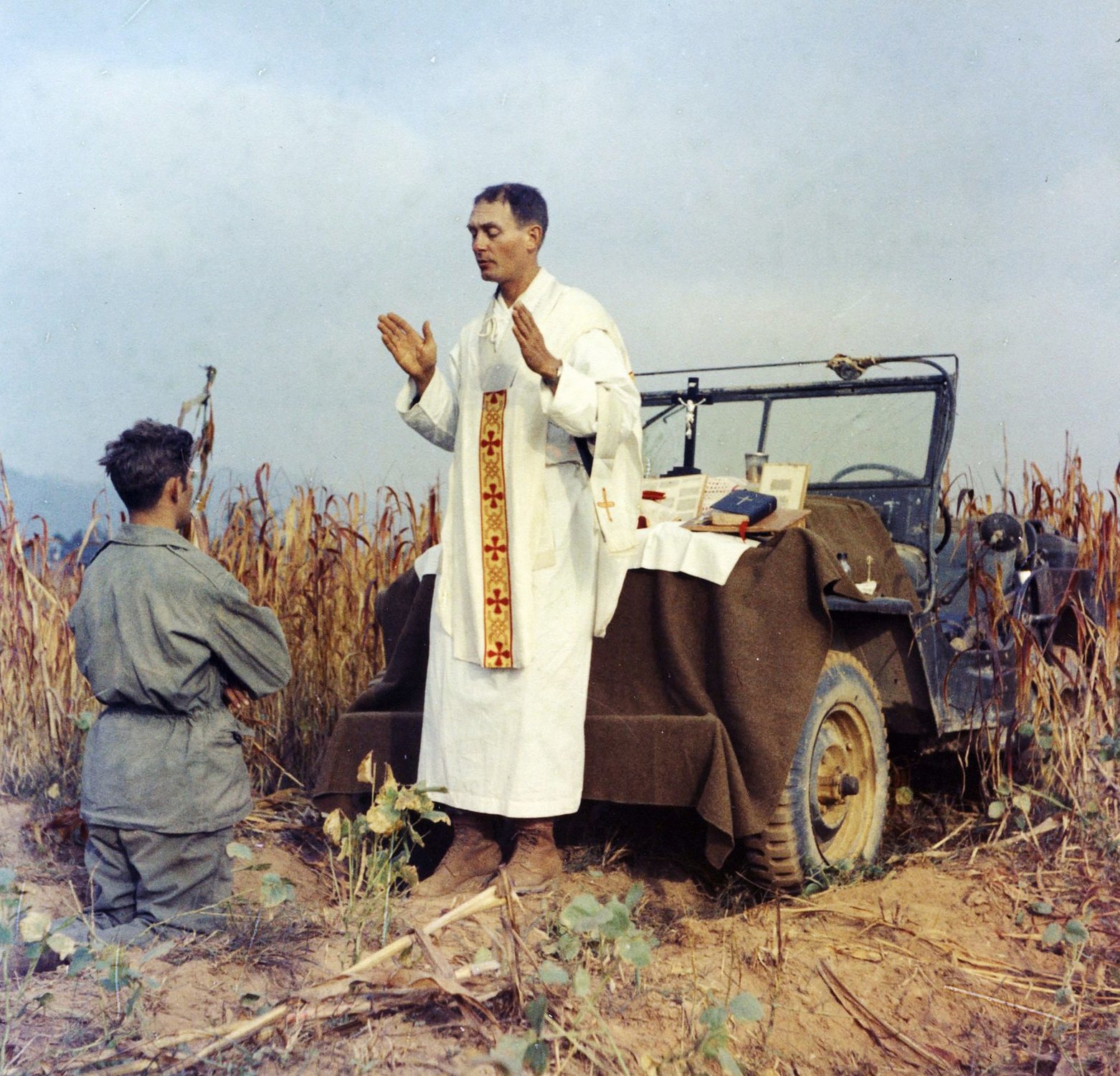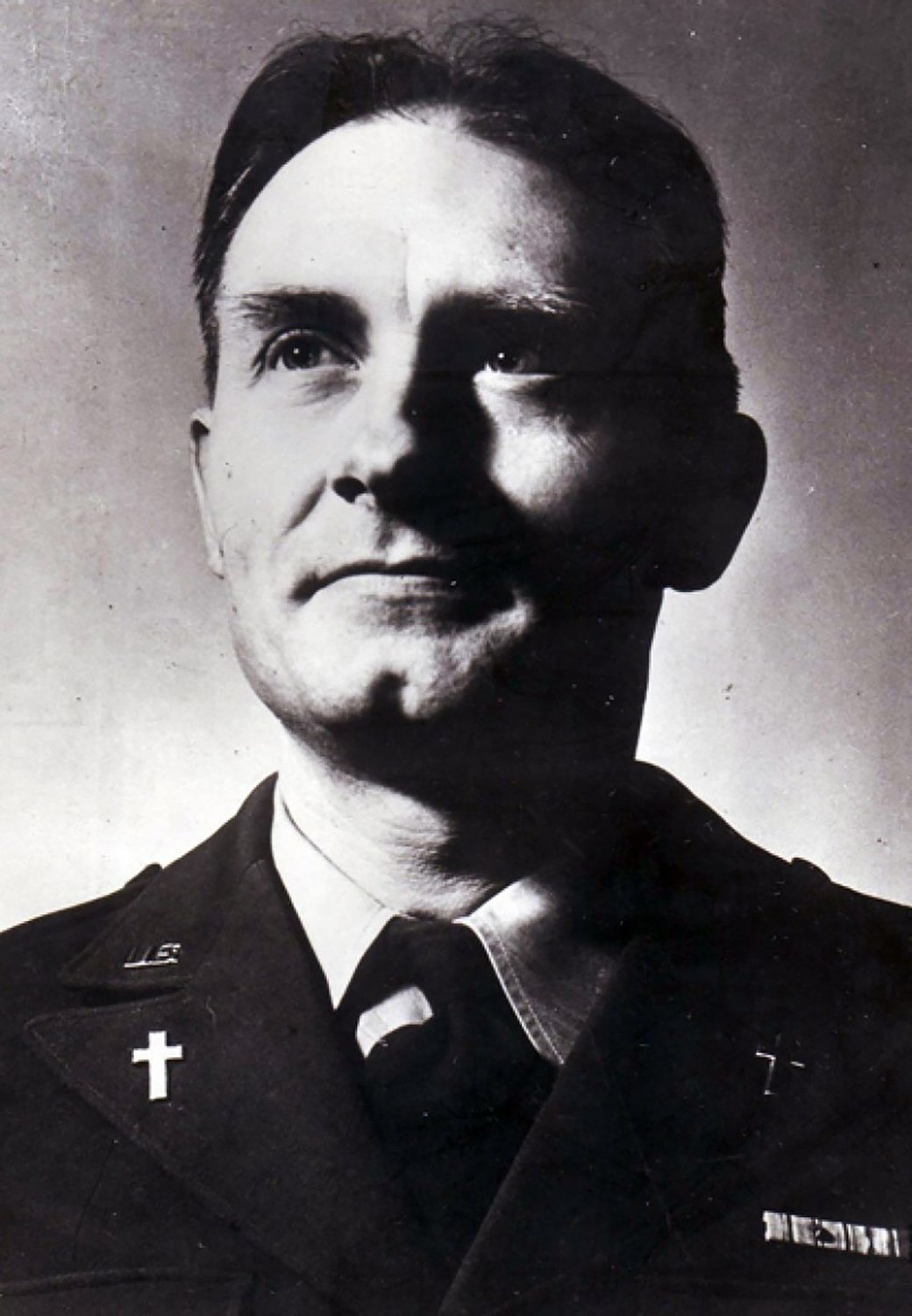Army Chaplain Who Received Medal of Honor for Actions in Korea Accounted For

Father Emil Kapaun celebrates Mass using the hood of his jeep as an altar, as his assistant, Patrick J. Schuler, kneels in prayer in Korea on Oct. 7, 1950, less than a month before Kapaun was taken prisoner. Kapaun died in a prisoner of war camp on May 23, 1951. (Col. Raymond A. Skeehan)
This article by Army Public Affairs was originally published on March 5, 2021.
WASHINGTON – The Defense POW/MIA Accounting Agency announced today that Korean War Medal of Honor recipient, Army Chaplain (Capt.) Emil Joseph Kapaun, has been accounted for.
Kapaun, of Pilsen, Kansas, served as a chaplain with the 3rd Battalion, 8th Cavalry Regiment, 1st Cavalry Division. On Nov. 2, 1950, the 3rd Battalion was near Unsan when the unit came under heavy fire and received orders to withdraw.
Eventually surrounded and besieged by Chinese Communist Forces, unit members became trapped and dug inside foxholes or behind bunkers. Kapaun stayed with the wounded but was soon captured and marched from village to village, with little food and shelter, to Old Pyoktong, later known as Chinese Camp 5, on the south bank of the Yalu River.

While a captive, he ministered to other prisoners of war, although he became mortally ill. He celebrated a final Easter Mass for the POWs in late March and shortly afterward was taken to the “sick house,” an old pagoda where he died of exhaustion and possible heart failure induced by pleurisy at the age of 35 on May 23, 1951.
Chaplain Kapaun repeatedly risked his own life to save the lives of hundreds of fellow Americans. His extraordinary courage, faith and leadership inspired thousands of prisoners to survive hellish conditions, resist enemy indoctrination and retain their faith in God and country.
“After 70 years Chaplain (Capt.) Kapaun has been accounted for. His heroism and resilient spirit epitomized our Army values of personal courage and selfless service,” said acting Secretary of the Army John E. Whitley.

In 1993, Pope John Paul II declared Chaplain Kapaun a servant of God, the first stage on the path to canonization. Kapaun was posthumously awarded the Medal of Honor by President Barack Obama at a White House ceremony on April 11, 2013.
Currently there are approximately 7,500 service members who served in the Korean War who remain unaccounted for. Accounting for Chaplain Kapaun “reaffirms our commitment to never leaving a fallen comrade,” said Chief of Staff of the Army James C. McConville.
For additional information on the Defense Department’s mission to account for Americans who went missing while serving our country, visit the DPAA website at www.dpaa.mil.
Read Next: From Priesthood to Korean War POW: Medal of Honor Recipient Emil Kapaun

Since 1943, ARNEWS has been the Army's premier print wire service with the daily mission of telling the service's story to its internal audiences worldwide. The general public is also a tertiary audience that can now view articles on Army.mil. But the target audience remains the 6 million Soldiers, Family members, retirees, reserve-component troops, civilian employees and contractors worldwide who traditionally read the stories in their command newspapers.
BRCC and Bad Moon Print Press team up for an exclusive, limited-edition T-shirt design!
BRCC partners with Team Room Design for an exclusive T-shirt release!
Thirty Seconds Out has partnered with BRCC for an exclusive shirt design invoking the God of Winter.
Lucas O'Hara of Grizzly Forge has teamed up with BRCC for a badass, exclusive Shirt Club T-shirt design featuring his most popular knife and tiomahawk.
Coffee or Die sits down with one of the graphic designers behind Black Rifle Coffee's signature look and vibe.
Biden will award the Medal of Honor to a Vietnam War Army helicopter pilot who risked his life to save a reconnaissance team from almost certain death.
Ever wonder how much Jack Mandaville would f*ck sh*t up if he went back in time? The American Revolution didn't even see him coming.
A nearly 200-year-old West Point time capsule that at first appeared to yield little more than dust contains hidden treasure, the US Military Academy said.












